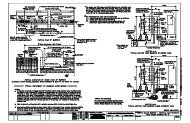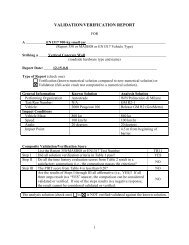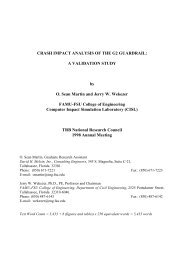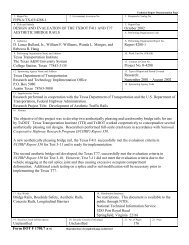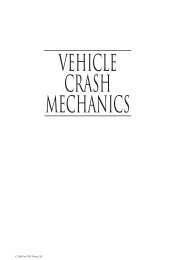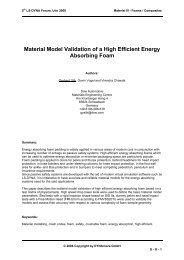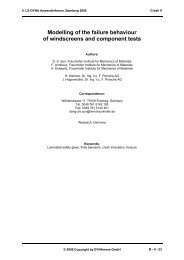Vehicle Crashworthiness and Occupant Protection - Chapter 3
Vehicle Crashworthiness and Occupant Protection - Chapter 3
Vehicle Crashworthiness and Occupant Protection - Chapter 3
You also want an ePaper? Increase the reach of your titles
YUMPU automatically turns print PDFs into web optimized ePapers that Google loves.
Finite Element Analytical Techniques<br />
<strong>and</strong> Applications to Structural Design<br />
When a safety-related problem appears in a prototype during a test, it is simulation<br />
that allows for diagnosis of the cause of the problem <strong>and</strong> selection of an appropriate<br />
structural modification in a minimal amount of time.<br />
Finally, it must be mentioned that numerical simulations have found their way<br />
into each aspect of traffic safety-related engineering, although the abovementioned<br />
design support work is certainly its main function. In addition to<br />
structural analysis, occupant simulation is increasingly performed using finite<br />
element models [26]. Simulations are used extensively by legislative bodies to<br />
support the development of new regulations [27] <strong>and</strong> for the improved design of<br />
roadside hardware [28].<br />
From the previous discussion, it is clear that numerical simulations enabled the<br />
car companies to comply with an otherwise impossible escalation of the regulatory<br />
environment. Only the extensive use of numerical simulation has enabled the<br />
motor vehicle industry to introduce increasingly safer cars <strong>and</strong> trucks in less time<br />
without a corresponding increase in test facilities.<br />
3.2 Overview of Explicit FE Technology<br />
FE crashworthiness analysis of transportation vehicles in general, <strong>and</strong> of ground<br />
vehicles in particular, is among the most challenging nonlinear problems in<br />
structural mechanics. <strong>Vehicle</strong> structures are typically manufactured from many<br />
stamped thin shell parts <strong>and</strong> subsequently assembled by various welding <strong>and</strong><br />
fastening techniques. The body-in-white may contain steel of various strength<br />
grades, aluminum <strong>and</strong>/or composite materials. During a crash incident, the<br />
structure experiences high impact loads which produce localized plastic hinges<br />
<strong>and</strong> buckling. This can ultimately lead to large deformations <strong>and</strong> rotations with<br />
contact <strong>and</strong> stacking among the various components. The deformations initially<br />
involve wave effects, associated with high stresses. Once these stresses exceed<br />
the yield strength of the material <strong>and</strong>/or its critical buckling load, localized<br />
structural deformations occur during a few wave transits in the structure. This is<br />
followed by inertial effects, which dominate the subsequent transient response.<br />
Of particular interest here are structural integrity <strong>and</strong> associated kinematics <strong>and</strong><br />
stacking of components, forces transmitted through the various members, stresses,<br />
strains, <strong>and</strong> energy absorption. In addition, the crash event may be considered<br />
as a low- to medium-dynamic event (5-100 mph), in comparison with ballistic<br />
impact, persisting for a short duration of 100-200 ms. Closed-form analytical<br />
solutions for this class of problems in structural mechanics present a formidable<br />
Page 117



